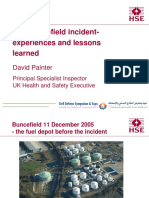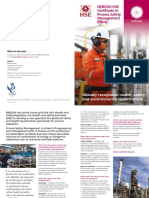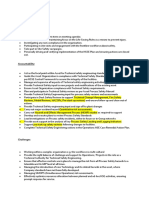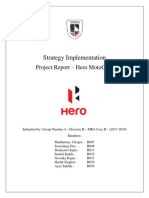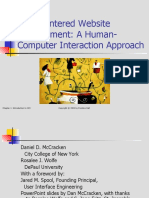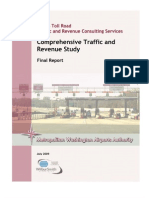Advances in LNG Hazard and Risk Assessment
Advances in LNG Hazard and Risk Assessment
Uploaded by
Vikas NaikCopyright:
Available Formats
Advances in LNG Hazard and Risk Assessment
Advances in LNG Hazard and Risk Assessment
Uploaded by
Vikas NaikOriginal Title
Copyright
Available Formats
Share this document
Did you find this document useful?
Is this content inappropriate?
Copyright:
Available Formats
Advances in LNG Hazard and Risk Assessment
Advances in LNG Hazard and Risk Assessment
Uploaded by
Vikas NaikCopyright:
Available Formats
Poster PO-18
ADVANCES IN LNG HAZARD AND RISK ASSESSMENT
J. S. Puttock G. A. Chamberlain S. Chynoweth J. J. Rowson Shell Global Solutions U.K. www.shellglobalsolutions.com
ABSTRACT The accurate assessment of hazards and risks for LNG facilities is crucial to understanding how a facility should be designed and operated. These assessments need to be rigorous and thorough to ensure that a project proceeds in the safest way. Over the years many advances have been made in this area. The paper covers some recent developments, for instance in the area of explosion prediction. Shell Global Solutions has developed an applied methodology that integrates risks from a variety of dispersion, fire and explosion hazards, including domino effects. This allows assessment of risk to people and assets on and off site. Recent improvements include allowance for the full range of possible explosion events. This is preferable to basing analysis on a worst case, which tends to overestimate hazards. We shall discuss this new explosion exceedance technique. which avoids the complex calculations that were previously necessary for modelling these events. We shall also describe the development of a layout tool for prompt analysis of risk in a facility in the design stage Such analysis was formerly more difficult owing to the need to provide detailed data that was not yet available. The emphasis of the methodology is on ease and speed of input and easily understood results. With this tool, it is quicker to lay out a new plant and obtain risk contours. Units can be quickly moved around and the risk recalculated. This enables us to optimise the footprint of LNG plant without compromising safety. This Paper is intended for general information purposes only and does not in any way constitute an offer to provide specific services.
PO-18.1
Poster PO-18
INTRODUCTION In LNG plant, as on other petrochemical sites, it is important to understand the hazards and risks associated with operation of the plant. It is crucial to have accurate assessment of such risks so that they can be minimized by the design and operation of the plant. In the Health, Safety and Environment Consultancy Group in Shell Global Solutions we have developed a methodology, known as Shepherd, that integrates risks from a variety of fire, dispersion and explosion hazards. It presents the risks to people and assets, on- and off-site, in a way that is easy to assimilate. In Shepherd, items such as process units and buildings are placed on a map and their relevant properties are specified. Output is principally via a range of graphs and contour plots such as Figure 1. The capability to trace back the contributors to risk at a particular location is also provided.
Figure 1.
Frequency of flammable vapour clouds for an example of a large petrochemical plant.
The hazards of vapour-cloud explosions were originally assessed in Shepherd by using a worst-case explosion in each unit. However, even if an explosion occurs, attaining the worst-case overpressure is unlikely; the gas cloud may only fill part of the plant area, and its concentration may not be near stoichiometric. For this reason, in most areas of explosion assessment, we have moved to using a probabilistic assessment of the entire range of possible explosion events. Results are often expressed as an exceedance curve, which is a plot of the frequency with which a given overpressure will be exceeded against that overpressure. (An example appears later in this paper in Figure 9.) Such an exceedance approach has been incorporated into Shepherd, and is described here.
PO-18.2
Poster PO-18
FULL EXCEEDANCE The most comprehensive method for analyzing the range of explosion hazards that a plant is exposed to, is the full probabilistic approach described by Puttock [1]. This is often used for offshore facilities, where personnel may be housed relatively close to plant, and a very detailed assessment is needed. We also carried out this full explosion exceedance study for all the processing units at a UK refinery. This involved a complete count of equipment, flanges, fittings and associated pipe-work with the potential to leak flammable fluids. Added to this were data on process streams (normal operating pressure, temperature and fluid composition), layout of the main equipment items (vessels, pumps, compressors, heat exchangers, furnaces, etc.), building construction types and occupancy levels. The methodology then calculated tens of thousands of vapour cloud dispersion and explosion scenarios to predict the consequences of all foreseeable explosions at occupied buildings on the site. Associated with each scenario is a frequency of individual risk derived from the frequency of the original leak multiplied by the ignition probability, the degree of overlap of the flammable cloud with congested areas of plant and vulnerability to explosion following damage to the building. To repeat this exercise for other sites would not be cost effective so a generic version has been developed and implemented into the Shepherd software and is described here. In this generic exceedance methodology, the input and processing of data is considerably reduced over the full exceedance and significant effort has been applied to minimise loss of accuracy. THE RISK ASSESSMENT METHODOLOGY The Shepherd risk software comprises a family of graphical risk integrators, containing the explosion exceedance methodology as well as other predictions such as risk of flammable gas, flame impingement and toxic hazards. Shepherd has been developed to carry out fit-for-purpose Quantified Risk Assessment (QRA) for a broad range of onshore industrial sites such as LNG plants, refineries, gas plants, chemicals plants, LPG distribution sites, pipeline systems, etc. For explosion exceedance calculations, in comparison to the full method described in the previous section, the Shepherd exceedance methodology is simpler, but more pragmatic. It described in detail by Chamberlain and Puttock [2]. For this approach the gas dispersion scenarios and their associated explosion overpressures and impulses have been collapsed onto two generic exceedance curves, one for flammable releases originating within the process unit comprising the congestion area and one for releases originating in adjacent areas. A flow chart outlining the Shepherd explosion methodology is shown in Figure 2. The information in the numbered boxes is further described below: 1. The dispersion distance to the lower flammable limit is calculated, to examine whether a flammable cloud released in one unit extends to adjacent congested areas. The release rate is determined by the fluid properties and hole size. A release frequency must also be assigned using, for example, EP Forum [3]. An ignition probability must be assigned to each release. The data recommended by Cox et al. [4] is one such source. The wind rose (direction, speed and stability histogram) is also defined at this stage.
PO-18.3
Poster PO-18
The SHEPHERD Methodology for Assessing Vulnerability of Building Occupants to Process Plant Explosions DATA COLLECTION 1a. Fluid Properties. Composition Pressure Temperature Hole size and frequency Direction and probability Location 1b. Distance to Lower Flammable limit SHEPHERD METHODOLOGY START DATA COLLECTION
1. Ignition probability 2. Worst Case Explosion 2a. Area congestion.
3a. Reactive vessel runaway properties and frequency 4a. Building data. Occupancy Building type
3. Generic exceedance curve for overpressure and impulse. Generic decay of blast into distance. 4. Generic building damage and occupant vulnerability 5. Fatality rate in terms of: A. Individual risk to the most exposed person in the building B. Potential loss of life (PLL)/yr for building and site C. Building and site F(N) END
Figure 2.
The simplified explosion exceedance methodology implemented in Shepherd
2. For each fuel type impacting the unit, a worst-case explosion calculation is performed to determine the source size, pulse duration and overpressure. The rule sets used are the Congestion Assessment Method, CAM [5-7], for vapour cloud explosions (using data from box 2a) and a modified BLEVE (Boiling Liquid Expanding Vapour Explosion) model [8-10] for vessel runaway explosions (using data from Box 3a). For enclosed process areas we assume that all flammable leaks within the enclosures are capable of filling it with a flammable mixture, that leaks within the enclosures will not migrate to neighbouring congested areas and that leaks from neighbouring process areas will not migrate into the enclosures. 3. The total frequencies of releases and worst case explosions are mapped onto generic exceedance curves for each congested area, one for internal vapour cloud hits and one for vapour cloud hits from external sources. The blast decay as pressure pulses move away from the source into the surroundings is also calculated at this stage. 4. The structural response of the building and building damage is coupled to the blast loading calculated in Box 3 by using the generic data contained in the 1995 Technology Co-Operative report prepared by Barker et al. [11]. Clearly more sophisticated building response calculations could be carried out if necessary. The
PO-18.4
Poster PO-18
vulnerability of occupants to building damage has been derived from studies by Oswald et al. [12], and by Jeffries et al. [13]. There are three vulnerability models programmed into Shepherd: the model published in API RP752 [14], a pressureonly method based on assumed pulse durations and a Pressure-Impulse (PI) method. The last two methods are based on the generic building types of Barker et al. [11]. 5. The fatality rates are derived from the time each individual spends in that building and the total amount of time that all occupants spend in the building. All fatality rates are summed and can be expressed in terms of risk markers such as Individual Risk, risk contours, Potential Loss of Life per annum, or F(N) (group risk) plots. Note that Shepherd exceedance ends with a prediction of the overall explosion risk per building or site. Application of risk tolerance and effectiveness of safety measures are decisions for the site. Shepherd exceedance is not intended to replace the full risk methodology, but it is a considerably more efficient way of carrying out the calculations. It is recommended that more detailed calculations should be carried out when making critical decisions, such as ones that involve severe consequences with borderline risks. The calculations are designed to satisfy the guidance given in API RP752 [14] and CCPS [15] on explosion risks. The results are expressed as the risk of fatality for the individual who is most exposed to building damage following an explosion in the plant. Also the group risk is calculated in terms of Potential Loss of Life (PLL)/yr and F[N] for the site employees who may also be exposed to the building explosion risk. These risk markers enable the derivation of guidance to satisfy a sites risk criteria by way of: 1. design overpressures for new buildings or upgrades to existing buildings, 2. the siting of temporary buildings, 3. the siting of new buildings, 4. the siting of new processing units 5. levels of building occupancy, and 6. identity of the main risk contributors THE LAYOUT TOOL The Shepherd exceedance method is very useful for quantifying explosion risk on existing plant. However, such risks are most easily controlled in the early stages of design, when plant layout is being planned. The layout tool, now incorporated in Shepherd, assists in this optimisation. At such an early stage, the data needed to run the normal explosion exceedance calculation are not available. For example, it is not possible to identify quantities and types of equipment on a unit that has not yet been designed. Thus a major part of the development of the layout tool was to gather data on typical characteristics of plant units of various types. These characteristics include level of congestion (needed for explosion assessment) and equipment counts. They can be scaled to take account of varying unit size. Leak frequencies used for the layout tool are based on these equipment counts and the Shepherd generic leak frequencies. This data gathering was performed both for refineries and LNG units.
PO-18.5
Poster PO-18
Specifically for the LNG layout tool, it is assumed that an LNG train can contain the following units Liquefaction Fractionation Sulphur removal Dehydration & Mercury Removal
QUALITY CHECK OF THE LNG LAYOUT METHODOLOGY As a quality check on the layout tool, the original process data for an LNG plant have been entered into Shepherd using conventional process blocks and generic leak frequencies for 10, 25, 50 and 100mm leaks. For comparison, the layout tool assessment was also performed.. The LNG layout tool was applied to all trains assuming that the only information available was the train footprints, building locations and building types. Figure 3 shows the flammable gas frequency from all the trains. Figure 4 shows the individual risk contours for occupants of B4 type buildings (steel or concrete frame with masonry fill or cladding). An occupancy level of 40hr/week is assumed. The yellow area for example indicates that the individual risk would be between 10-5/year and 10-4/year for someone spending forty hours per week in a B4 building in that location.
Figure 3.
Flammable gas frequency
PO-18.6
Poster PO-18
Figure 4.
Individual risk contours for occupants of B4 buildings. Assumes 40hr/week occupancy.
Figure 5 shows a comparison of predictions of individual risk from the normal Shepherd assessment and the layout tool. An occupancy level of 40hr/week has been assumed. Clearly there is good agreement between the two approaches.
PO-18.7
Poster PO-18
LNG Trains Shepherd Exceedance v Layout
1.00E-04 Shepherd exceedance Layout
Individual Risk /yr
1.00E-05
1.00E-06
1.00E-07 Building 1 Building 2 Building 3 Building 4 Building 5 Building 6 Building 7 Building 8 Building 9 Building 10 Building 11 Building 12 Building 13
Figure 5. A comparison of the individual risk calculations for occupants of B3 buildings, as calculated by the original Shepherd method and the layout tool. A SIMPLE EXAMPLE As a example of the use of the layout tool, we show (Figure 6) a hypothetical LNG train with an occupied building of B2 type (steel frame, metal sides) and maximum occupancy level of 40 hr/week located 87m away. Let us assume that it is desired to keep the maximum individual risk below 10-4/year. The proposal is to locate an identical train as close as possible to the existing one and to predict the increased risk to building occupants. The maximum individual risk (MIR) to building occupants from the existing train is 6.9E-05 per year, which meets the chosen criterion.
PO-18.8
Poster PO-18
Figure 6.
A hypothetical LNG train with a nearby building. Contours of individual risk for occupants of B2 buildings are plotted.
Figure 7 shows the proposed location for the new train. Risks from both trains operational. The MIR to building occupants is now 1.3E-04 per year, which exceeds the project criterion.
Figure 7.
The effect on explosion risk of adding a new train.
PO-18.9
Poster PO-18
There are then several options to satisfy the chosen risk criterion: Re-locate the building. The choice of location can be based on the risk contours and confirmed by dragging the building to the new location and recalculating Strengthen the building based on the free-field overpressure and impulse exceedance graphs. An example is shown in Figure 9 and described below. Choose a new location for the new train. This can be assessed by dragging the process block to various new locations with the mouse and recalculating. An example is shown in Figure 8
Figure 8.
As Figure 7, with the new train moved.
Graphical results can also be obtained. Figure 9 is an exceedance plot for free-field overpressure at the building, that is showing the frequency with which any specified overpressure will be exceeded. Impulse can be plotted in the same way.
PO-18.10
Poster PO-18
Figure 9.
An exceedance plot of free-field overpressure at the building location.
MORE COMPLEX LAYOUT A final example (Figure 10) shows the layout tool applied to a plant with a more varied mix of units and buildings. In this case the contours of the frequency of overpressure exceeding 100 mbar are plotted.
Figure 10.
The layout tool applied to a plant with a more varied mix of units and buildings.
PO-18.11
Poster PO-18
CONCLUSIONS Shepherd provides an organised way of recording the data relevant to calculations of a wide range of risk associated with petrochemical plant of any level of complexity. It then performs the risk integration and provides a range of displays which assist in the understanding of the results. It is straightforward, for example, to refer to a contour plot when making decisions about the siting of temporary buildings. Once the model of a plant is built, it would normally be kept as a live document, incorporating plant changes as they occur, evaluating such changes when they are planned and increasing detail where necessary. Until recently, the requirements for detailed data on plant units has precluded the use of Shepherd in the early stages of plant design, when layout is being optimised. The addition of the layout tool now makes this possible. It is usually the case that some of the lowest-cost options to reduce risk occur when the layout is being planned. The ability to move units around easily on the map, and immediately assess the effect on various risk parameters is very beneficial. REFERENCES CITED 1. Puttock, J. S. The use of a combination of explosion models in explicit overpressure exceedance calculations for an offshore platform. Proc. Int. Conf. Major Hazards Offshore - practical implications, London, November 2000. Chamberlain, G.A. and J.S.Puttock, Vapour cloud explosion risk management in onshore plant using explosion exceedance techniques. Hazards XIX, I.Chem.E., 2006. E&P Forum EP Forum Hydrocarbon Leak and Ignition Database, EP Forum Report No. 11.4/180, E&P Forum, London, 1992. Cox, A.W., F.P. Lees and M.L. Ang, Classification of hazardous locations. I.Chem.E., 1990. Puttock, J.S "Fuel gas explosion guidelines - The Congestion Assessment Method", 2nd European Conf. on Major Hazards Onshore and Offshore, I.Chem.E., Manchester, 1995. Puttock, J.S. Improvements in guidelines for prediction of vapour cloud explosions, Intl. Conference and Workshop on Modelling and Consequences of Accidental Releases of Hazardous Materials. San Francisco, Sep-Oct 1999. Puttock, J.S. Developments in the congestion assessment method for prediction of vapour cloud explosions, 10th International Symposium, Loss Prevention and Safety Promotion in the Process Industries, Stockholm, 19-21 June 2001, p11071133. Shield, S.R. "A model to predict the radiant heat transfer and blast hazards from LPG BLEVEs." AIChE Symp. Series, Vol. 89, 1993. Baker, W.E., P.A.Cox, P.S.Westine, J.J.Kulesz, and R.A.Strehlow Explosion Hazards and Evaluation, Elsevier, 1983. Lees, F.P. Loss Prevention in the Process Industries, Reed Educational and Professional Publishing, 1996, Chapter 17.
2.
3. 4. 5.
6.
7.
8. 9. 10.
PO-18.12
Poster PO-18
11.
Barker, D.D., M.J.Lowak, C.J.Oswald, J.P.Peterson, M.W.Stahl, and J.H.Waclawczyk Final Report: Conventional Building Blast Performance Capabilities, 1995 Technology Cooperative, Wilfred Baker Engineering Inc., 1996 (Confidential). Oswald, C. J. and Q.A.Baker Vulnerability Model for Occupants of Blast Damaged Buildings, 34th Annual Loss Prevention Symposium, March 6-8, 2000. Jeffries, R.M., L.Gould, D.Anastasiou and R Pottrill Derivation of fatality probability functions for occupants of buildings subject to blast loads, Phase 4. WS Atkins Science and Technology Contract Research Report 147/1997. API Recommended Practice 752, Management of Hazards Associated with Locations of Process Plant Buildings. May 1995. Center for Chemical Process Safety (CCPS) of the American Institute of Chemical Engineers Guidelines for Evaluating Process Plant Buildings for External Explosions and Fires., 1996.
12. 13.
14. 15.
PO-18.13
You might also like
- Fra Lippo Lippi by Robert BrowningDocument19 pagesFra Lippo Lippi by Robert BrowningArchy SolankiNo ratings yet
- Explosion Risk Analysis ERA' For FLNG Facilities: The Main ChallengesDocument6 pagesExplosion Risk Analysis ERA' For FLNG Facilities: The Main ChallengesAndro SiregarNo ratings yet
- Accuracy in QRADocument8 pagesAccuracy in QRAJohm Robert taylor100% (1)
- Client: BMT India Document: Terms of References For Quantitative Risk Assessment StudyDocument10 pagesClient: BMT India Document: Terms of References For Quantitative Risk Assessment StudyAnurag BholeNo ratings yet
- Quantitative Risk Analysis (QRA) : Germanischer Lloyd - Service/Product DescriptionDocument12 pagesQuantitative Risk Analysis (QRA) : Germanischer Lloyd - Service/Product DescriptionMani KalyanaramanNo ratings yet
- Diference Between HAZID and HAZOPDocument2 pagesDiference Between HAZID and HAZOPQueziaNo ratings yet
- ALARPDocument7 pagesALARPArgenis José Medina SotilloNo ratings yet
- Instructions: Industrial EcologyDocument5 pagesInstructions: Industrial EcologyAdamNo ratings yet
- Dropped Object Reference ReportDocument18 pagesDropped Object Reference Reportsnikraftar1406No ratings yet
- Index: CIA Guidance For The Location and Design of Occupied Building On Chemical Manufacturing SitesDocument16 pagesIndex: CIA Guidance For The Location and Design of Occupied Building On Chemical Manufacturing SitesMr NU KHANNo ratings yet
- 042 Thomas KDocument17 pages042 Thomas KИгорь НаумовичNo ratings yet
- The Buncefield Expolsion & Fire - Dr. David PainterDocument32 pagesThe Buncefield Expolsion & Fire - Dr. David PainterorlcostaNo ratings yet
- S-006 NorsokDocument28 pagesS-006 NorsokYesid Diaz CastroNo ratings yet
- Vess FireDocument21 pagesVess FirecsNo ratings yet
- OGP - Occupational Risk - March 2010Document14 pagesOGP - Occupational Risk - March 2010btjajadiNo ratings yet
- Burnaby Fire Department - Evidentiary PaperDocument96 pagesBurnaby Fire Department - Evidentiary PaperNationalObserverNo ratings yet
- Shahrul Nazmi Bin Othman: Process Safety EngineerDocument4 pagesShahrul Nazmi Bin Othman: Process Safety EngineerShahrul Nazmi OthmanNo ratings yet
- Safeti 3D Explosions - The Delta - MexicoDocument20 pagesSafeti 3D Explosions - The Delta - MexicolopezmoramiguelNo ratings yet
- 6 - Appendix D2 - Risk Assessment PDFDocument95 pages6 - Appendix D2 - Risk Assessment PDFEmiliano VendittiNo ratings yet
- Phast 6.7Document4 pagesPhast 6.7Sunil Kumar100% (1)
- Flares ImDocument270 pagesFlares ImnelsonsenaNo ratings yet
- Overview of Bowtie Methodology of Risk Analysis and Its ApplicationDocument6 pagesOverview of Bowtie Methodology of Risk Analysis and Its ApplicationakhyudinNo ratings yet
- QRADocument10 pagesQRApgupta71100% (1)
- ALARP PrincipleDocument1 pageALARP Principlekenoly123No ratings yet
- HAZOP Budgeting Tool: Practical Solutions For Today's HSE ChallengesDocument2 pagesHAZOP Budgeting Tool: Practical Solutions For Today's HSE ChallengesifalerinNo ratings yet
- Sea Change: Offshore Safety and The Legacy of Piper Alpha: AnalysisDocument3 pagesSea Change: Offshore Safety and The Legacy of Piper Alpha: Analysiscrackerz83No ratings yet
- Overview of Consequence Modelling in The Hazard As PDFDocument9 pagesOverview of Consequence Modelling in The Hazard As PDFmarius_brkt62840% (1)
- A Simple Problem To Explain and Clarify The Principles of Risk CalculationDocument20 pagesA Simple Problem To Explain and Clarify The Principles of Risk CalculationjoseoliverosNo ratings yet
- Uncertainty Aspects in Process Safety AnalysisDocument9 pagesUncertainty Aspects in Process Safety Analysis安妮No ratings yet
- Emissions From Gas Processing Platforms To The Atmosphere-Case Studies As PublishedDocument11 pagesEmissions From Gas Processing Platforms To The Atmosphere-Case Studies As PublishedOlabayo OlaopaNo ratings yet
- GAP.2.5.1.A Illustrations PDFDocument2 pagesGAP.2.5.1.A Illustrations PDFEnrique BlancoNo ratings yet
- QraDocument10 pagesQraNakkolopNo ratings yet
- Ed Temporary Refuge Integrity PDFDocument27 pagesEd Temporary Refuge Integrity PDFWAPP0% (1)
- Fault - Event Trees Main PresentDocument76 pagesFault - Event Trees Main PresentTabishNo ratings yet
- Air Modelling ReportDocument8 pagesAir Modelling ReportadiNo ratings yet
- 8 Vedlegg BDocument13 pages8 Vedlegg BGilang RomadhonNo ratings yet
- Hazard IdentificationDocument2 pagesHazard IdentificationSultanNo ratings yet
- Hazard Analysis of Crude Oil Storage Tank Farm: International Journal of Chemtech Research November 2018Document10 pagesHazard Analysis of Crude Oil Storage Tank Farm: International Journal of Chemtech Research November 2018Redzwan KadirNo ratings yet
- Gu 230Document78 pagesGu 230kattabommanNo ratings yet
- Assumption Sheet 01Document12 pagesAssumption Sheet 01Nambi PurushothNo ratings yet
- Using Layers of Protection Analysis To Evaluate Fire and Gas SystemsDocument6 pagesUsing Layers of Protection Analysis To Evaluate Fire and Gas SystemsStevenNo ratings yet
- Hazop-Gas Processing ComplexDocument2 pagesHazop-Gas Processing ComplexjavadNo ratings yet
- 7 May 2015 EISC FLNG Safety ReportDocument331 pages7 May 2015 EISC FLNG Safety ReportSaraNo ratings yet
- HSE Certificate in Process Safety Management Leaflet - A5 - AW2 - Web222017221413Document2 pagesHSE Certificate in Process Safety Management Leaflet - A5 - AW2 - Web222017221413midozoty100% (1)
- A Quantitative Individual Risk Assessment Method in Process Facilities With Toxic Gas Release Hazards A Combined Scenario Set and CFD ApproachDocument9 pagesA Quantitative Individual Risk Assessment Method in Process Facilities With Toxic Gas Release Hazards A Combined Scenario Set and CFD ApproachSteven100% (1)
- The Use of Hazop Techniques in Applied Hazard ProcessesDocument72 pagesThe Use of Hazop Techniques in Applied Hazard Processesamidi5555913No ratings yet
- A Preliminary Analysis of Volcanic Na-Tech Risks in The Vesuvius AreaDocument8 pagesA Preliminary Analysis of Volcanic Na-Tech Risks in The Vesuvius AreaerNo ratings yet
- CF Lecture 12 Hazard IdentificationDocument78 pagesCF Lecture 12 Hazard IdentificationMatthew AdeyinkaNo ratings yet
- Epsc PSFDocument23 pagesEpsc PSFKNS GroupNo ratings yet
- Hazard Analysis: Total Flooding Extinguishing SystemDocument14 pagesHazard Analysis: Total Flooding Extinguishing SystemJose Antonio LaraNo ratings yet
- Flammability Characteristcs of Light Hydrocarbons and Their Mixtures at Elevated ConditionsDocument211 pagesFlammability Characteristcs of Light Hydrocarbons and Their Mixtures at Elevated Conditionshsny116No ratings yet
- HazardIdentification FinalDocument100 pagesHazardIdentification FinalAHSA 309100% (1)
- LNG Safety IdeaDocument6 pagesLNG Safety Ideawaking_daysNo ratings yet
- Hazid Report Form: Project: Drawing Nos Date: Sheet No: Area or System: AttendeesDocument12 pagesHazid Report Form: Project: Drawing Nos Date: Sheet No: Area or System: AttendeesElias EliasNo ratings yet
- Shell JDDocument3 pagesShell JDpmnasimNo ratings yet
- Pipelines LOCDocument28 pagesPipelines LOCuserscribd2011100% (1)
- Risk Bow-Tie MethodDocument21 pagesRisk Bow-Tie MethodchatraqnNo ratings yet
- Practical Framework For Process Safety ManagementDocument13 pagesPractical Framework For Process Safety ManagementSubhi El Haj Saleh100% (1)
- Control of Major Accident Hazards Regulations 2015 (Comah)Document50 pagesControl of Major Accident Hazards Regulations 2015 (Comah)S.KalatheeswaranNo ratings yet
- Emergency Relief System Design Using DIERS Technology: The Design Institute for Emergency Relief Systems (DIERS) Project ManualFrom EverandEmergency Relief System Design Using DIERS Technology: The Design Institute for Emergency Relief Systems (DIERS) Project ManualRating: 4 out of 5 stars4/5 (1)
- Structured What If Technique A Complete Guide - 2020 EditionFrom EverandStructured What If Technique A Complete Guide - 2020 EditionNo ratings yet
- SECTION 15180 BMS and Automatic ControlsDocument32 pagesSECTION 15180 BMS and Automatic ControlskdpmansiNo ratings yet
- Big Data Analytics in Telecommunications: Literature Review and Architecture RecommendationsDocument22 pagesBig Data Analytics in Telecommunications: Literature Review and Architecture RecommendationsImam SudrajatNo ratings yet
- Standard Penetration TestDocument59 pagesStandard Penetration TestcuervohijoguachoNo ratings yet
- Translste Gebhar Scram - 11-35Document25 pagesTranslste Gebhar Scram - 11-35indra purnamaNo ratings yet
- Management Science - HomeworkDocument15 pagesManagement Science - HomeworkVinaNo ratings yet
- 9413-Article Text-69284-1-10-20230823Document12 pages9413-Article Text-69284-1-10-20230823jannairaputriwNo ratings yet
- Hazard Analysisand Critical Control Point HACCPPlanfor Carbonated Soft Drinks PlantDocument17 pagesHazard Analysisand Critical Control Point HACCPPlanfor Carbonated Soft Drinks Plant8061077No ratings yet
- 3a. The Coastal ZoneDocument140 pages3a. The Coastal Zoneb_osborne100% (1)
- Apartment Planning Concept in Settlement Area of Sleman DistrictDocument8 pagesApartment Planning Concept in Settlement Area of Sleman DistrictauliaNo ratings yet
- state-board-textbook-class-11th-environmentalDocument85 pagesstate-board-textbook-class-11th-environmentalUkunal KunalNo ratings yet
- Strategy Implementation: Project Report - Hero MotocorpDocument30 pagesStrategy Implementation: Project Report - Hero MotocorpSANYUJ ZADGAONKARNo ratings yet
- Gödels First Incompleteness Theorem in Simple Symbols and Simple TermsDocument5 pagesGödels First Incompleteness Theorem in Simple Symbols and Simple TermsbambambholeNo ratings yet
- Full download Energy Efficiency 1st Edition Daniel M. Martinez pdf docxDocument41 pagesFull download Energy Efficiency 1st Edition Daniel M. Martinez pdf docxlabbygrown8x100% (2)
- Dokumen - Tips - Caterpillar Cat 14m Motor Grader Prefix b9j Service Repair Manual b9j00001 and UpDocument27 pagesDokumen - Tips - Caterpillar Cat 14m Motor Grader Prefix b9j Service Repair Manual b9j00001 and UpOrrego DanielNo ratings yet
- Spare Parts List: CR 10-X CR Reader CR 12-X CR Advanced Reader CR 15-X CR Multiformat ReaderDocument16 pagesSpare Parts List: CR 10-X CR Reader CR 12-X CR Advanced Reader CR 15-X CR Multiformat Readermecool acemax100% (1)
- 2023 Dănilă Et AlDocument24 pages2023 Dănilă Et AlmdudumanNo ratings yet
- Post and Core FabricationDocument8 pagesPost and Core FabricationSaj1985No ratings yet
- Chapter 1 Global Marketing ManagementDocument30 pagesChapter 1 Global Marketing ManagementAdiba AnisNo ratings yet
- Harris ScarfDocument6 pagesHarris ScarfHudaNo ratings yet
- Revisi Pengadaan Obat 2023 New 2Document62 pagesRevisi Pengadaan Obat 2023 New 2bahrulmaghfiroh CINo ratings yet
- ABM ReviewerDocument7 pagesABM ReviewerMaria Francheska GarciaNo ratings yet
- Toyota RS2000 - User ManualDocument3 pagesToyota RS2000 - User ManualSzelestey Tamás "ToME"No ratings yet
- Introduction To Amul: Indian Dairy Cooperative Society Anand Indian GujaratDocument5 pagesIntroduction To Amul: Indian Dairy Cooperative Society Anand Indian Gujaratmihir aggarwalNo ratings yet
- Septiembre 2024Document12 pagesSeptiembre 2024donelarias1993No ratings yet
- User-Centered Website Development: A Human-Computer Interaction ApproachDocument37 pagesUser-Centered Website Development: A Human-Computer Interaction ApproachJavian CampbellNo ratings yet
- Wilbur Smith Traffic - Study - 2009Document215 pagesWilbur Smith Traffic - Study - 2009Terry MaynardNo ratings yet
- Intermec Despiece 1Document48 pagesIntermec Despiece 1tron69No ratings yet
- Astm E711 1987Document9 pagesAstm E711 1987BS100% (1)
- Pertemuan 11 Metodologi PenelitianDocument3 pagesPertemuan 11 Metodologi PenelitianAdji LanangNo ratings yet











